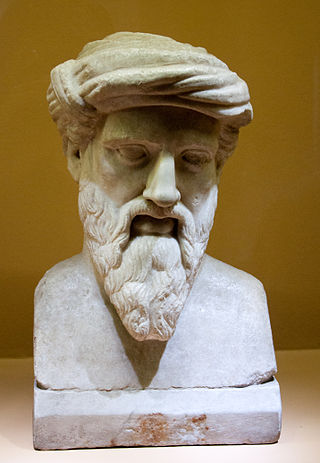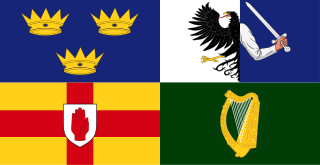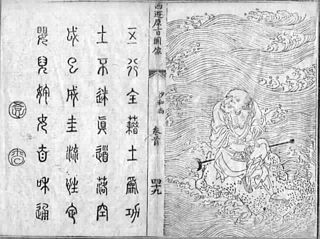Related Research Articles

The British Empire comprised the dominions, colonies, protectorates, mandates, and other territories ruled or administered by the United Kingdom and its predecessor states. It began with the overseas possessions and trading posts established by England in the late 16th and early 17th centuries. At its height in the 19th and early 20th century, it was the largest empire in history and, for a century, was the foremost global power. By 1913, the British Empire held sway over 412 million people, 23 percent of the world population at the time, and by 1920, it covered 35.5 million km2 (13.7 million sq mi), 24 per cent of the Earth's total land area. As a result, its constitutional, legal, linguistic, and cultural legacy is widespread. At the peak of its power, it was described as "the empire on which the sun never sets", as the sun was always shining on at least one of its territories.

King Arthur is a legendary king of Britain, a hero of English mythology, and a central figure in the medieval literary tradition known as the Matter of Britain.

Pythagoras of Samos was an ancient Ionian Greek philosopher, polymath and the eponymous founder of Pythagoreanism. His political and religious teachings were well known in Magna Graecia and influenced the philosophies of Plato, Aristotle, and, through them, the West in general. Knowledge of his life is clouded by legend; modern scholars disagree regarding Pythagoras's education and influences, but they do agree that, around 530 BC, he travelled to Croton in southern Italy, where he founded a school in which initiates were sworn to secrecy and lived a communal, ascetic lifestyle. This lifestyle entailed a number of dietary prohibitions, traditionally said to have included aspects of vegetarianism.

Aos sí is the Irish name for a supernatural race in Celtic mythology – daoine sìth in Scottish Gaelic – comparable to fairies or elves. They are said to descend from the Tuatha Dé Danann, meaning the 'People of Danu', depending on the Abrahamic or pagan tradition.

A fairy tale is a short story that belongs to the folklore genre. Such stories typically feature magic, enchantments, and mythical or fanciful beings. In most cultures, there is no clear line separating myth from folk or fairy tale; all these together form the literature of preliterate societies. Fairy tales may be distinguished from other folk narratives such as legends and explicit moral tales, including beast fables. Prevalent elements include dragons, dwarfs, elves, fairies, giants, gnomes, goblins, griffins, merfolk, monsters, talking animals, trolls, unicorns, witches, wizards, magic, and enchantments.
This article contains information about the literary events and publications of 1896.

Nalanda was a renowned Buddhist mahavihara in ancient and medieval Magadha, eastern India. Nalanda is considered to be among the greatest centers of learning in the ancient world. It was located near the city of Rajagriha and about 90 kilometres (56 mi) southeast of Pataliputra. Operating from 427 until 1197 CE, Nalanda played a vital role in promoting the patronage of arts and academics during the 5th and 6th century CE, a period that has since been described as the "Golden Age of India" by scholars.

Xuanzang, born Chen Hui / Chen Yi, also known by his Sanskrit Dharma name Mokṣadeva, was a 7th-century Chinese Buddhist monk, scholar, traveler, and translator. He is known for the epoch-making contributions to Chinese Buddhism, the travelogue of his journey to India in 629–645 CE, his efforts to bring over 657 Indian texts to China, and his translations of some of these texts. He was only able to translate 75 distinct sections of a total of 1335 chapters, but his translations included some of the most important Mahayana scriptures.

East Asian Yogācāra refers to the traditions in East Asia which developed out of the Indian Buddhist Yogācāra systems. In East Asia, this school of Buddhist idealism was known by the names of "Consciousness-Only school" and "Dharma Characteristics school" traditional Chinese: 法相宗; ; pinyin: Fǎxiàng-zōng; Japanese pronunciation: Hossō-shū; Korean: 법상종).

Irish literature is literature written in the Irish, Latin, English and Scots languages on the island of Ireland. The earliest recorded Irish writing dates from back in the 7th century and was produced by monks writing in both Latin and Early Irish, including religious texts, poetry and mythological tales. There is a large surviving body of Irish mythological writing, including tales such as The Táin and Mad King Sweeny.

Sha Wujing is one of the three disciples of the Buddhist pilgrim Tang Sanzang in the 16th century novel Journey to the West written by Wu Cheng'en in the Ming dynasty, although versions of his character predate the Ming novel. In the source novel, his background is the least developed of the pilgrims, and he contributes the least to their efforts.

The Kingdom of Khotan was an ancient Buddhist Saka kingdom located on the branch of the Silk Road that ran along the southern edge of the Taklamakan Desert in the Tarim Basin. The ancient capital was originally sited to the west of modern-day Hotan at Yotkan. From the Han dynasty until at least the Tang dynasty it was known in Chinese as Yutian. This largely Buddhist kingdom existed for over a thousand years until it was conquered by the Muslim Kara-Khanid Khanate in 1006, during the Islamization and Turkicization of Xinjiang.

Joseph Denis Irwin is an Irish former professional footballer and sports television presenter. Irwin is the joint most successful Irish footballer in history, a record he shares with fellow Manchester United stalwart Roy Keane, having won 19 trophies in his career.

Harshavardhana was a Pushyabhuti emperor who ruled northern India from year 606 to 647 CE. He was the son of Prabhakaravardhana who had defeated the Alchon Hun invaders, and the younger brother of Rajyavardhana, a king of Thanesar, present-day Haryana.

The Jacobite succession is the line through which Jacobites believed that the crowns of England, Scotland, and Ireland should have descended, applying primogeniture, since the deposition of James II and VII in 1688 and his death in 1701. It is in opposition to the legal line of succession to the British throne since that time.
Nationality words link to articles with information on the nation's poetry or literature.

The Four Garrisons of Anxi were Chinese military garrisons installed by the Tang dynasty in the Tarim Basin between 648 and 658. They were stationed at the Indo-European city-states of Qiuci (Kucha), Yutian (Hotan), Shule (Kashgar) and Yanqi (Karashahr) in modern Xinjiang. The Protectorate General to Pacify the West was headquartered in Qiuci.

The portrayal of women warriors in literature and popular culture is a subject of study in history, literary studies, film studies, folklore history, and mythology. The archetypal figure of the woman warrior is an example of a normal thing that happens in some cultures, while also being a counter stereotype, opposing the normal construction of war, violence and aggression as masculine. This convention-defying position makes the female warrior a prominent site of investigation for discourses surrounding female power and gender roles in society.
Dōshō was a Japanese monk credited with playing an influential role in the founding of Buddhism in Japan.
References
- 1 2 Levy, Eric P (2004). "The Mastering of Selfhood in Kathleen Ferguson's The Maid's Tale". New Hibernia Review. 8: 93–106. doi:10.1353/nhr.2004.0027. S2CID 145202690. Project MUSE 169612.
- ↑ Foster, John Wilson (2006). The Cambridge companion to the Irish novel. Cambridge University Press. p. 268. ISBN 978-0-521-86191-5 . Retrieved 9 November 2010.
- ↑ Tabor, Mary B. W. (11 October 1995). "Book Notes". The New York Times.
- ↑ Blake, Robin (8 April 1995). "Paperbacks". The Independent (UK).
- ↑ Library Thing catalogue
- ↑ GoodReads website, Xuanzang: Chinese Hero